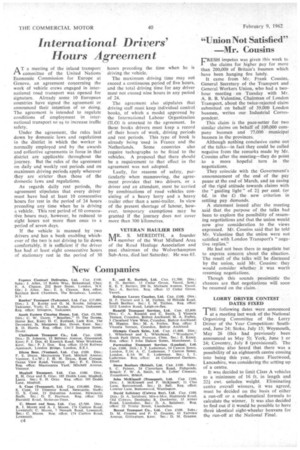International Drivers' Hours Agreement
Page 36

If you've noticed an error in this article please click here to report it so we can fix it.
AT a meeting of the inland transport committee of the United Nations Economic Commission for Europe at Geneva, an agreement concerning the work of vehicle crews engaged in international road transport was opened for signature. Already some 10 European countries have signed the agreement or announced their intention of so doing. The agreement is intended to regulate conditions of employment in international transport so as to increase traffic safety.
Under the agreement, the rules laid down by domestic laws and regulations in the district in which the worker is normally employed and by the awards and collective agreements in force in that district are applicable throughout the journey. But the rules of the agreement on daily and weekly rest periods and on maximum driving periods apply wherever they are stricter than those of the domestic laws and regulations.
As regards daily rest periods, the agreement stipulates that every driver must have had at least 10 consecutive hours for rest in the period of 24 hours preceding any time when he is driving a vehicle. This rest period of. 10 consecutive hours may, however, be reduced to eight hours not more than once in a period of seven days.
If the vehicle is manned by two drivers and has a bunk enabling whichever of the two is not driving to lie down comfortably, it is sufficient if the driver has had at least eight consecutive hours of stationary rest in the period of 30 hours preceding the time when he is driving the vehicle.
The maximum driving time may not exceed a continuous period of five hours, and the total driving time for any driver must not exceed nine hours in any period of 24.
The agreement also stipulates that driving staff must keep individual control books, of which a model approved by the International Labour Organization (ILO) is annexed to the agreement. In these books drivers must keep a record of their hours of work, driving periods and rest periods. This type of book is already being used in France and the Netherlands. Some countries also require tachographs to he fitted to the vehicles. A proposal that there should be a requirement to that effect in the agreement was not adopted.
Lastly, for reasons of safety, particularly when manceuvring, the agreement provides that two drivers, or a driver and an attendant, must be carried by combinations of road vehicles consisting of a heavy lorry and a heavy trailer other than a semi-trailer. In view of the present shortage of labour, however, temporary exemptions may he granted if the journey does not cover more than 300 kilometres.
















































































































